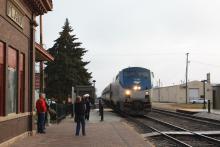
Decatur, Illinois (pop. 71,000) is moving forward with an Institutional Network (I-Net) expansion that will connect 11 school districts and 3 firehouses to its growing fiber-optic backbone, connecting potential commercial and industry customers along the way.
The city of Decatur has been expanding its fiber network since 2014, when it decided to deploy a backbone network connecting several of its facilities. This most recent expansion will extend the access to Franklin and Parsons schools, Stephen Decatur Middle School, Eisenhower and MacArthur high schools, American Dreamer STEM Academy, Dennis Lab School, Hope Academy, Johns Hill Magnet School and William Harris Learning Academy.
The expansion is the result of a 5-0 city council vote in April approving a $915,000 contract with Bodine Electric to purchase and hang 144 strand fiber-optic cable.
A portion of the funding for the contract will come from a $800,000 grant from the Connect Illinois grant program, an initiative aimed at expanding broadband access. The program launched in 2019 with $420-million investment in broadband infrastructure. The first round of grants totaled $50 million with a combined $9.25 million going to monopoly ISPs CenturyLink, MediaCom, Spectrum, and Comcast and the rest going to local ISPs and city and county governments.
The remaining $115,000 allocated in the contract will come from the state’s portion of the American Rescue Plan fund.
While the city will fund the expansion of the backbone to pass by the schools and connect the firehouses, Decatur Public Schools (DPS) will also contribute $600,000 to connect the schools to the street fiber. The contribution is also from the Connect Illinois Grant Program.
When the state grants came through, the city and DPS saw an opportunity to collaborate.
“We very quickly started talking to each other, and [we already have a] network out in the streets, and so we decided we would do this together,” City Administrator Scot Wrighton told ILSR in an interview.
The city recently made the policy decision to open up its network to commercial and industrial customers after requests started coming in.
“[Our network] was set up, initially, to cobble together public facilities,” Wrighton said. “If you look at a map of our system, it looks a little odd because it doesn’t follow all of the commercial corridors. It goes to where we’ve had requests or where we planned to put it for anticipating future needs.”
Construction on the expansion has begun, but Wrighton said that it has been relatively slow, because like many other communities throughout the country trying to build networks, fiber resources have been in high demand.







